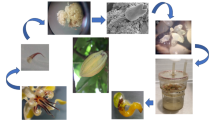Abstract
Floral buds ofBrowallia demissa, at three stages of development, were cultured on Nitsch and Nitsch basal medium. The supplements used include IAA; several cytokinins— benzyladenine, kinetin and 6-benzyl-9 tetrahydropyran-adenine (SD 8339); gibberellic acid (GA3); 2, 3, 5-triiodobenzoic acid (TIBA); arginine and cysteine. All three stages of floral buds failed to complete development. In some treatments stages II and III produced callus and/or roots from the morphological basal end. Cytokinins promoted bud formation whereas both IAA and GA3 depressed bud formation The shoots differentiatedin vitro were capable of setting flowers, fruits and seeds in all the treatments. The seeds were viable. Comparative studies of development of flowersin vivo andin vitro were made. In some treatments the flowers exhibited abnormal corolla, and roecium and gynoecium. Factors affecting normal bud initiation, organization and development are discussed.
Abstract
Květní pupenyBrowallia demissa ve třech vývojových stádiích byly pěstovány na základním mediu Nitsch a Nitsch. Do media byla přidávána IAA, některé cytokininy—benzyladenin, kinetin a 6-benzyl-9-tetrahydropyran-adenin (SD 8339); kyselina giberelová (GA3); kyselina 2,3,5-trijodbenzoová; arginin a cystein. V žádné variantě podle stádia pupenu nedošlo k úplnému vývoji. V některých variantách stádia II a III docházelo ke vzniku kalusu a nebo kořenů z báze pupenů. Cytokininy napomáhaly tvoření pupenů, zatímco jak IAA tak GA potlačily jejich vznik. Stonky diferencovanéin vitro byly schopné vytvořit květy, plody a semena ve všech variantách. Semena byla životaschopná. Byl srovnáván vývoj květůin vitro ain vivo. V některých variantách se v květech vytvářely abnormální květní obaly, androceum a gyneceum. Jsou diskutovány faktory ovlivňjící normální vývoj a organizaci pupene.
Abstract
Выращивались цветочные почкиBrowalia demissa на трех стадиях развития на основной среде по Нитч и Нитч. Добавки к среде: ИУК, некоторые дитокинины—бензиладенин, кинетин и 6-бензил-9-тетрагидропиран-аденин (SD 8339); гибберелловая кислота (GA3); 2,3,5-трийодбензойная кислота; аргинин и цистеин. Полное развитие не происходило ни в одном из вариантов. В некоторых вариантах II и III стадии образовался каллус или корни из основания почек. Цитокинины способствовали образованию почек в то время как ИУК и ГК подавляли их возникновение. Стебли дифференцированныеin vitro были способны образовать цветы, плоды и семена во всех вариантах. Семена были жизнеспособны. Сравнивали развитие цветовin vivo иin vitro. В некоторых вариантах в цветах образовывались аномальные корона, андроцей и гинецей. Обсуждаются факторы влияющие на нормальное развитие и организацию почки.
Similar content being viewed by others
References
Blake, J. Flower apices culturedin vitro—Nature211: 990–991, 1966.
Caplin, S. M., Griesel, W. O.: Induction of floral primordia in isolated nodal explants ofCestrum diurnum in vitro.—Am. J. Bot.54: 596–600, 1967
Galun, E, Jung, Y., Lang, A.: Morphogenesis of floral buds of cucumber culturedin vitro.— Dev. Biol.6: 370–387, 1963.
Goldschmidt, E. E., Monselise, S. P.: Citrus petal bioassay based on the indolyl-3-acetic acid effect on flower opening—Nature212: 1065–1066, 1966.
Heslop-Harrison, J., Heslop-Harrison, Y.: Long-day and auxin induced male sterility inSilene pendula L.—Portug. Acta Biol. (A)5: 79–94, 1958.
Konar, R. N., Nataraja, K.:In vitro control of floral morphogenesis inRanunculus sceleratus L. —Phytomorphology14: 558–563, 1964.
Margara, J., Rancillac, M., Bouniols, A: Récherches expérimentales sur la néoformation de bourgeons inflorcentiels ou végétatifsin vitro á partir d’explants d’endive (Cichorium intybus L.) 3II. Etude critique de la méthode.—Ann. Physiol. veg.8: 285–305, 1966.
Mohan, Karuna, Km.: The ovule and embryo sac development inBrowallia demissa Linn.— Proc. Indian Acad. Sci.64: 26–31, 1966.
Mohan Ram, H. Y., Rustagi, P. N.: Phytogametocidal compounds.—Sci. Cult32: 286–291, 1966.
Murashige, T.: The role of gibberellin in shoot differentiation in tobacco tissue culture.— In:White, P. R., Grove, A. R., (Eds.): Proc. Int. Con. Pl. Tissue Culture. McCutchen Publishing Corporation, Calif., pp. 321–330, 1965.
Murashige, T., Nakano, R.: Tissue culture as a potential tool in obtaining polyploid plants.— J. Hered.57: 115–118, 1966.
Nitsch, J. P.: Towards a biochemistry of flowering and fruiting: Contributions ofin vitro technique. —Proc. XVII Int. hort. Congr.3: 291–308, 1967.
Nitsch, J. P., Nitsch, C.: The induction of floweringin vitro in stem segments ofPlumbago indica L. I: The production of vegetative buds.—Planta72: 355–370, 1967a.
Nitsch, J. P., Nitsch, C.: The induction of floweringin vitro in stem segments ofPlumbago indica L. II: The production of reproductive buds.—Planta72: 371–384, 1967b.
Pierik, R. L. M.: Regeneration, vernalization and flowering inLunaria annua L.in vivo andin vitro.—Meded. Landbouwogeschool, Wageningen67: 1–71, 1967.
Porath, D., Galun, E.:In vitro culture of hermaphrodite floral buds ofCucumis melo L.: microsporogenesis and ovary formation.—Ann. Bot. (N. S.)31: 283–290, 1967.
Raghavan, V.: Studies on the floral histogenesis and physiology ofPerilla III. Effects of IAA on the flowering of apical buds and explants in culture.—Am. J. Bot.48: 870–876, 1961.
Rustagi, P. N.: Evaluation of mendok and dalapon as male gametocides and their effects on growth and yield of linseed, flax and wheat.—Ph. D. Thesis, Univ. Delhi 1967.
Skoog, F. andMiller, C. O.: Chemical regulation of growth and organ formation in plant tissue culturedin vitro.—Symp. Soc. exp. Biol.11: 188–131, 1957
Steinberg, R. A.: Flowering responses of a variety ofNicotiana rustica to organic compounds in aseptic culture.—Am. J. Bot.37: 547–551, 1950.
Tepfer, S. S., Greyson, R. I., Craig, W. R., Hindman, J. L.:In vitro culture of floral buds ofAquilegia.—Am. J. Bot.50: 1035–1045, 1963.
Torrey, J. G.: The initiation of organized development in plants—In:Abercrombie, M., Brachet, J., (Eds); Advances in Morphogenesis, Academic Press5, pp. 39–91, 1966.
Author information
Authors and Affiliations
Additional information
The plates will be found at the end of the issue.
Rights and permissions
About this article
Cite this article
Ganapathy, P.S. Floral morphogenesis and flowering in aseptic cultures ofBrowallia demissa L. Biol Plant 11, 165–174 (1969). https://doi.org/10.1007/BF02921735
Received:
Issue Date:
DOI: https://doi.org/10.1007/BF02921735




